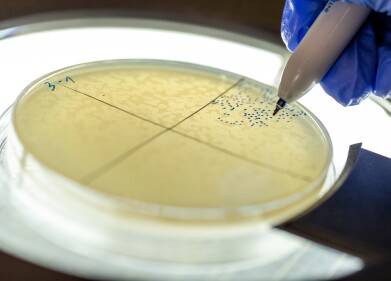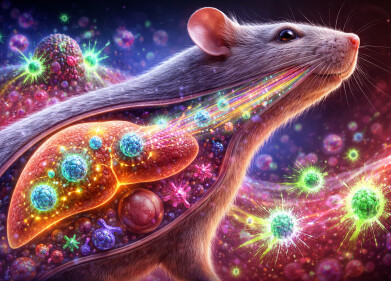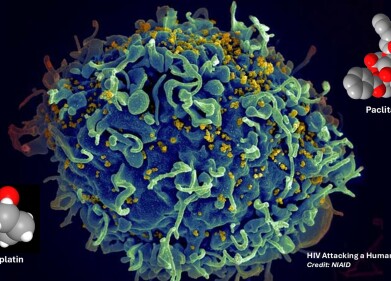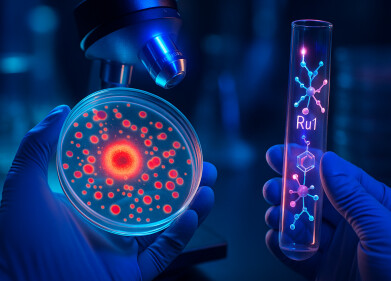-
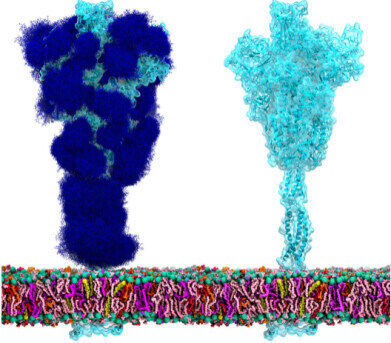 Removing the glycans – shown as dark blue in the left hand illustration – from a coronavirus’ spike protein leads to greater vaccine efficacy. Credit: Lorenzo Casalino
Removing the glycans – shown as dark blue in the left hand illustration – from a coronavirus’ spike protein leads to greater vaccine efficacy. Credit: Lorenzo Casalino
Research news
‘Low-sugar’ vaccine offers broad coronavirus variants immunity
Mar 27 2025
Being sugar-coated doesn’t just help the medicine go down, as the song goes, but it can also help a virus evade the immune system. However, researchers have now developed a universal vaccine that targets the sugars used by coronaviruses – such as the SARS-CoV-2 virus that brought about the COVID-19 pandemic – that they use as protective cover.
Animal studies showed that the vaccine removed sugar molecules from an area of a coronavirus spike protein that rarely mutates and then created effective and plentiful antibodies to inactivate the virus.
Professor Chi-Huey Wong, Department of Chemistry, The Scripps Research Institute, La Jolla, California presented his team’s results at the American Chemical Society’s Spring 2025 Digital Meeting, March 23-25, 2025.
Wong said that research provided for the development of an effective vaccine that could target more than one coronavirus at a time, allowing patients to receive a single inoculation to protect against a variety of pathogens. An ongoing Phase I clinical trial led by Rock Biotherapeutics has completed enrolment and dosing and will be discussed by Wong during his ACS Spring 2025 Digital Meeting presentation.
“For a lot of vaccines, like smallpox and tetanus, we only have to be immunised once,” Wong said, “but we have to take a flu shot every year.”
Wong added that the high mutation rate seen in the SARS-CoV-2 virus – specifically, the receptor binding domain on the virus’ spike protein – has led to a large number of COVID-19 vaccine updates.
The low-mutation region targeted by the team for the vaccine sits in the stalk region of the virus’ spike protein. However, this stalk is coated with chains of sugar molecules called glycans from the host’s cells. And this coating prevents antibodies from being able to recognise, and therefore inactivate, the virus.
The researchers therefore developed a ‘low sugar’ vaccine that can remove the glycans that are shielding access to the virus’ spike protein through enzymatic digestion. It then creates antibodies that specifically targets the low-mutation stalk region of the spike protein, should the actual virus enter the body.
In hamster and mouse models, the universal vaccine created more diverse antibodies with higher titers – concentrations in the blood, where immune system cells travel throughout the body – compared to individual vaccines against variants of SARS-CoV, as well as MERS-CoV, the coronavirus that caused the Middle East Respiratory Syndrome outbreak in 2012.
In addition to vaccines for viral infections, Wong’s team is developing the technique to produce vaccines for oncology applications. They recently published two studies on glycan targets on cancer cells and enzymes linked to the synthesis of glycans on cancer cells in the Journal of the American Chemical Society.
Digital Edition
Lab Asia Dec 2025
December 2025
Chromatography Articles- Cutting-edge sample preparation tools help laboratories to stay ahead of the curveMass Spectrometry & Spectroscopy Articles- Unlocking the complexity of metabolomics: Pushi...
View all digital editions
Events
Jan 21 2026 Tokyo, Japan
Jan 28 2026 Tokyo, Japan
Jan 29 2026 New Delhi, India
Feb 07 2026 Boston, MA, USA
Asia Pharma Expo/Asia Lab Expo
Feb 12 2026 Dhaka, Bangladesh
